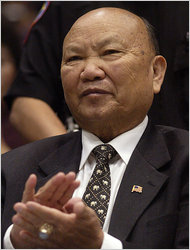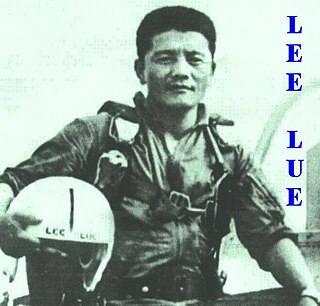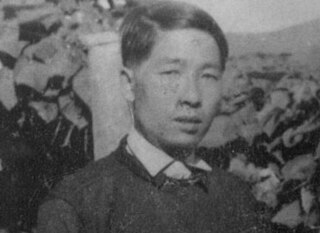Related Research Articles

The Hmong people are an indigenous group in East and Southeast Asia. In China, the Hmong people are classified as a sub-group of the Miao people. The modern Hmong reside mainly in Southwest China and countries in Southeast Asia such as Vietnam, Laos, Thailand, and Myanmar. There is also a large diasporic community in the United States of more than 300,000. The Hmong diaspora has smaller communities in Australia and South America.

Vang Pao was a major general in the Royal Lao Army and later a leader of the Hmong American community in the United States.

The Laotian Civil War (1959–1975) was a civil war in Laos waged between the Communist Pathet Lao and the Royal Lao Government from 23 May 1959 to 2 December 1975. It is associated with the Cambodian Civil War and the Vietnam War, with both sides receiving heavy external support in a proxy war between the global Cold War superpowers. It is known as the Secret War among the American CIA Special Activities Center, and Hmong and Mien veterans of the conflict.

Air America is a 1990 American action comedy film directed by Roger Spottiswoode and starring Mel Gibson and Robert Downey Jr. as Air America pilots flying missions in Laos during the Vietnam War. When the protagonists discover their aircraft is being used by government agents to smuggle heroin, they must avoid being framed as the drug-smugglers.

Hmong Americans are Americans of Hmong ancestry. Many Hmong Americans immigrated to the United States as refugees in the late 1970s. Over half of the Hmong population from Laos left the country, or attempted to leave, in 1975, at the culmination of the Laotian Civil War.
The insurgency in Laos is a low-intensity conflict between the Laotian government on one side and former members of the Secret Army, Laotian royalists, and rebels from the Hmong and lowland Lao ethnic minorities on the other. These groups have faced reprisals from the Lao People's Army and Vietnam People's Army for their support of the United States-led, anti-communist military campaigns in Laos during the Laotian Civil War, which the insurgency is an extension of itself. The North Vietnamese invaded Laos in 1958 and supported the communist Pathet Lao. The Vietnamese communists continued to support the Pathet Lao after the end of the Laotian Civil War and the establishment of the Lao People's Democratic Republic. At least 100,000 Hmong civilians were killed as the result of Laotian governmental policies, in what has sometimes been referred to as the Hmong genocide.

Major Lee Lue was a Laotian Hmong fighter bomber pilot notable for flying more combat missions than any other pilot in the Kingdom of Laos. Lee Lue flew continuously, as many as 10 missions a day and averaging 120 combat missions a month to build a total of more than 5,000 sorties. Lee Lue was the leader of the special group of Hmong pilots flying T-28Ds from Long Tieng against the Pathet Lao and North Vietnamese positions. The group was funded by the CIA and was part of the regular Royal Lao Air Force, but took orders directly from MR2 Commander Gen. Vang Pao. His T-28 was shot down by anti-aircraft fire over Muang Soui, crashing in a mountainous area near Ban Phou Pheung Noi on July 12, 1969. At the time of his death, he had flown more combat missions than any other pilot in history.

The Hmong and Lao Memorial, or Lao Veterans of America Monument, is a granite monument, bronze plaque and living memorial in Arlington National Cemetery in the US. Dedicated in May 1997, it is located in Section 2 on Grant Avenue between the path to the JFK memorial and the Tomb of the Unknowns, in Arlington National Cemetery, Arlington, Virginia, in the United States. The Laos–Hmong memorial commemorates the veterans of the "Secret War" in Laos who fought against invading Soviet Union-backed North Vietnam Army forces of the People's Army of Vietnam and communist Pathet Lao guerrillas. Approved by the U.S. Department of Defense, Arlington National Cemetery, and the U.S. Department of the Army, but designed and paid for privately by the Lao Veterans of America, Inc., the Lao Veterans of America Institute, and The Centre for Public Policy Analysis, the memorial stands as a tribute to the Hmong, Lao, other ethnic groups, and American clandestine and military advisers who made up the Secret War effort during the Vietnam War. The Lao Veterans of America, Inc. is the nation's largest ethnic Laotian- and Hmong-American veterans organization.

The Battle of Lima Site 85, also called Battle of Phou Pha Thi, was fought as part of a military campaign waged during the Vietnam War and Laotian Civil War by the North Vietnamese People's Army of Vietnam (PAVN) and the Pathet Lao, against airmen of the United States Air Force (USAF)'s 1st Combat Evaluation Group, elements of the Royal Lao Army, Royal Thai Border Patrol Police, and the CIA-led Hmong Clandestine Army. The battle was fought on Phou Pha Thi mountain in Houaphanh Province, Laos, on 10 March 1968, and derives its name from the mountaintop where it was fought or from the designation of a 700-foot (210 m) landing strip in the valley below, and was the largest single ground combat loss of United States Air Force members during the Vietnam War.

Shong Lue Yang was a Hmong spiritual leader and creator of the Pahawh script, a semi-syllabary for writing dialects of the Hmong language, as well as the Khmu language.

Relations between Laos and the United States officially began when the United States opened a legation in Laos in 1950, when Laos was a semi-autonomous state within French Indochina. These relations were maintained after Laos' independence in October 1953.
Vang Pobzeb was a Hmong American dedicated to Lao and Hmong human rights. For over 25 years, he was an outspoken critic of the Marxist governments of the Pathet Lao in Laos and the Socialist Republic of Vietnam (SRV) and their human rights violations, religious freedom violations, and persecution of the Lao and Hmong people.
The Hin Heup massacre was the massacre of 14 Hmong civilians at Hin Heup bridge by Pathet Lao troops.
The Center for Public Policy Analysis (CPPA), or Centre for Public Policy Analysis, was established in Washington, D.C., in 1988 and describes itself as a non-profit, non-partisan, think tank and research organization. The CPPA is a non-governmental organization (NGO) focused on foreign policy, national security, human rights, refugee and international humanitarian issues. Its current executive director is Philip Smith.
Jerrold B. Daniels or Jerry Daniels was a CIA Paramilitary Operations Officer (PMOO) in their Special Activities Center who worked in Laos and Thailand from the early 1960s to the early 1980s. He was known by his self-chosen CIA call-sign of "Hog." In the early 1960s, he was recruited by the CIA as a liaison officer between Hmong General Vang Pao and the CIA. He worked with the Hmong people for the CIA's operation in Laos commonly called the "Secret War" as it was little known at the time. In 1975, as the communist Pathet Lao and North Vietnamese Army advanced on the Hmong base at Long Tieng, Daniels organized the air evacuation of Vang Pao and more than two thousand of his officers, soldiers, and their families to Thailand. Immediately after the departure of Daniels and Vang Pao, thousands more Hmong fled across the Mekong river to Thailand, where they lived in refugee camps. From 1975 to 1982 Daniels worked among Hmong refugees in Thailand facilitating the resettlement of more than 50,000 of them in the United States and other countries.
May Song Vang was an American Hmong community leader and activist. She was the widow of General Vang Pao, a former member of the Royal Lao Army and prominent Hmong American leader, who died in 2011. May Song Vang became a more prominent symbol of the Hmong American community in California and the rest of the United States after the death of her husband.
The Auto Defense de Choc (ADC) was a militia training program for the Royal Lao Armed Forces. Begun by a French military mission in 1955, its 100-man companies were placed under command of the local Military Region commander when trained. By 1 September 1959, 20 ADC companies were in training, and there were 16,000 ADC soldiers nationwide. When Central Intelligence Agency (CIA) operatives Theodore Shackley, James William Lair and others slipped into the Kingdom of Laos in the early 1960s, they instituted an American version of the ADC dependent on pre-packed airdropped materiel. Using a three-day training schedule in Operation Momentum, Shackley, Lair and others, worked with Vang Pao to raise a guerrilla force of 5,000 troops in several months.

Wangyee Vang is a Hmong-American community leader, educator and elder from Fresno, and the Central Valley, of California.

Ban Phou Pheung Noi is a Laotian village located at the peak of Phou Pheung mountain in the Xieng Khouang province of Laos. Phou Pheung mountain is approximately 916 m (3,005 ft). During the Vietnam War, combat between the American allies, the Hmong, and the Pathet Lao, The Laos Marxist government, and the Communist North Vietnamese People's Army took place on the mountain. Phou Pheung mountain runs from east to west and is rocky, and is covered in tropical forests. It is south of Muang Soui - Nongtang-Nato, and west of Phou Douk, Muang Phuan, Phonsavan and Plain of Jars. To the east, about 10 miles from Ban Phou Pheung Noi, is the Num Ngum 4 hydroelectric dam.
References
- ↑ Greater Appalachian Llama and Alpaca Association Newsletter, January 2016, http://www.galaonline.org
- 1 2 Noble County, Indiana, Death Records. "Genealogical and Death Records of Noble County, Indiana, Noble County, Indiana, December 23, 2010, Death Notice, Claude LaRowe". gen.nobleco.lib.in.us. Noble County, Indiana, Public Library. Retrieved 25 June 2016.
{{cite web}}: CS1 maint: multiple names: authors list (link) - 1 2 3 4 5 6 7 8 9 10 11 "Jane Hamilton-Merritt". Connecticut Women's Hall of Fame website.
- ↑ Greater Appalachian Llama and Alpaca Association, January 2016, http://www.galaonline/board.html
- ↑ Smith, J. Christina. The Hmong, 1987-1995: A Selected and Annotated Bibliography, p. 11.
- 1 2 Isthmus, 10 April 2007, Madison, Wisconsin, "Alfred McCoy Briefing Paper"